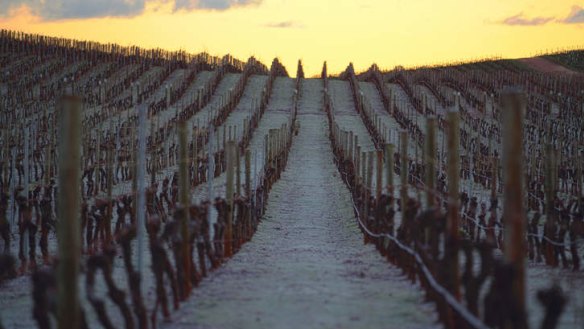Why Tasmanian pinot noir matters
It's barely a blip on the Australian wine scene but this chilly southern isle provides a refuge from climate change.

Tasmania produces less than 1 per cent of Australia's wine.
The amount of pinot noir grown on the island is a trickle of the national pinot figure: 12.5 per cent.
So, barely registering a blip on the Australian wine scene, why should anyone care about Tassie pinot noir? Because it matters.

Facing a future where many Australian wine regions are expected to get hotter and less likely to produce pinot noir of any great suppleness or charm, Tasmania offers a refuge.
''Projected climate warming for Tasmania, compared to other wine-growing regions in Australia and overseas, is relatively low,'' says one of the world's leading authorities on climate change and viticulture, Dr Leanne Webb, the CSIRO's climate projections liaison manager.
It matters because of the diversity 68,000 square kilometres of island can bring to just one grape variety. And it matters because Tasmania is arguably the most exciting pinot noir producer in Australia.
There's something about Tasmanian pinot fruit that creates more expression in the glass than other Australian wine-growing regions. Whether it's with bubbles (sparkling) or without (table wines), when grown in Tasmanian soil the grape shows delicacy and grace but with an underlying steel structure.
And as we are discovering, Tassie pinot noir ages so very well.
House of Arras late-disgorged 2002 chardonnay/pinot noir sparkling is a case in point. ''It's still very fresh and it's what we were trying to achieve,'' says Arras winemaker Ed Carr of the wine's continued youthfulness after 12 years in a bottle.
At Moorilla Estate's recent 50th birthday celebration, the last four bottles of founder Claudio Alcorso's 1991 reserve pinot noir were broached and respectfully drunk. It was an extraordinary wine - a savoury mix of sweet cherry and earthy fungal delights.
Dr Andrew Pirie has spent 40 years dissecting the connection between Tassie's climate and its grapes, first at Pipers Brook Vineyard (now Kreglinger Wine Estates), which he founded in 1974, and today at his own small-scale sparkling wine label, Apogee. He argues there are two important aspects to Tassie's cool climate when it comes to pinot noir: the cool, humid areas and the cool, dry ones.
''Champagne and Burgundy are cool humid areas and you get a different response from the vines,'' he says. ''The grape composition is more delicate, less tannic.'' He sources and prizes fruit for his Apogee label from the cool, humid Pipers River area of north-east Tassie.
Cool, dry places can produce more tannin in the fruit, whereas cool, humid areas give more delicate fruit flavours. This is the yin and yang of winegrowing in Tassie.
Charles ''Chilly'' Hargrave, group sparkling winemaker for Treasury Wine Estates, has spent nine years exploring the vast differences between the state's north and south. The Tamar Valley and Pipers Brook areas around Launceston are warmer and generally give higher yields. ''They produce good commercial wines,'' he says, ''with more floral notes and warm, round fruit flavours.''
Down south is where he gets truly excited. ''It's marginal,'' he says, a note of approval in his voice. ''Around Hobart is drier, the soils are tougher; you don't get the vine vigour or the obvious fruitiness.'' What you do get, he is convinced, is something Burgundian.
''You get purity, you get line,'' he enthuses. Structure, focus overlaid with complex fruit - ''not big cherry bombs'' - is what he dreams about.
So, why does Tassie pinot noir matter?
Because it tastes so damn good. It rarely suffers from high alcohol or busy oak.
As winemakers and viticulturists have learnt to deal with cool-climate conditions, past inconsistencies from vintage to vintage have become less apparent.
Small operators such as Joe Holyman and Project X, with their garagiste-style peculiarities, challenge and confront, while bigger companies appear willing to protect the essence of what they have been blessed with.
But it's time to stop talking of Tasmanian pinot noir as a single entity. Let's acknowledge the state's seven distinctive sub-regions: North-West (Devonport), Tamar Valley, Pipers River, East Coast (Bicheno), Coal River Valley, Derwent Valley and the Huon Valley.
That would be a good start.
A little sparkle and heaps of style
Pinot noir represents more than 40 per cent of all Tasmanian grape plantings – 623 of 1538 hectares. About 45 per cent is used in sparkling wines, the rest sport no bubbles ... just style. Here are some to track down.
Abel's Tempest 2012 Pinot Noir, Tamar Valley ($32): Bright cherries, earth, spice, clean tannic snap.
Bay of Fires 2010 Pinot Noir, Pipers River ($49.99): Rose, five-spice, meaty, with a lean finish.
Clarence Plains 2013 JV Pinot Noir, Derwent Valley ($25.50): Lively, fresh, plums, svelte.
Glaetzer-Dixon Reveur 2011 Pinot Noir, Coal Valley ($63.95): Exotic fragrance, dark fruits, complexity to burn, lithe.
Holm Oak 2013 Pinot Noir, Tamar Valley ($32): Wild strawberries, savoury, spice, chalky dry.
Home Hill 2011 Pinot Noir, Huon Valley ($36): Sweet fruit, sappy, silky texture, focus.
Jansz Vintage Rosé Sparkling 2010, Pipers River ($47.90): Pale tea rose, dried flowers, cranberry, delicate.
Kelvedon 2011 Pinot Noir, south-east coast ($35): Rhubarb, fresh herbs, tight, long.
Moorilla Muse 2013 Pinot Noir, Derwent Valley ($48): Dark, violets, plum, supple.
Stoney Rise 2013 Pinot Noir, Tamar Valley ($29): Sour cherry, big mouthful of black fruit, texture, firm.